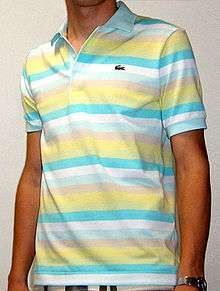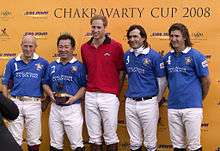Polo shirt
A polo shirt is a form of shirt with a collar, a placket neckline with three buttons, and an optional pocket. Polo shirts should be buttoned to the top and are usually short sleeved; they were originally used by polo players during the 1920s.[1]

Polo shirts are usually made of knitted cotton (rather than woven cloth), usually a piqué knit, or less commonly an interlock knit (the latter used frequently, though not exclusively, with pima cotton polos), or using other fibers such as silk, merino wool, synthetic fibers, or blends of natural and synthetic fibers. A dress-length version of the shirt is called a polo dress.[2]
History
History of the polo shirt
At the end of the 19th century, outdoor activities became important for the British ruling class. Jodhpur pants and polo shirts became part of the wardrobe for horse-related sports.[3] The two garments were brought back from India by the British, along with the game of polo. The original polo shirts were more like contemporary button down sport shirts. They were buttoned, long- or short-sleeved shirts, distinguished by being made of more rugged material than dress shirts and featuring button-down collars to prevent the collars from flapping around when riding on horseback. For this reason, Brooks Brothers markets its line of oxford cloth button down shirts as "Original Polo."
History of the tennis shirt

In the 19th and early 20th centuries, tennis players ordinarily wore "tennis whites" consisting of long-sleeved white button-up shirts (worn with the sleeves rolled up), flannel trousers, and ties.[4][5][6] This attire presented problems for ease of play and comfort.[5]
René Lacoste, the French seven-time Grand Slam tennis champion, felt that the stiff tennis attire was too cumbersome and uncomfortable.[5] He designed a white, short-sleeved, loosely-knit piqué cotton (he called the cotton weave jersey petit piqué) shirt with an unstarched, flat, protruding collar, a buttoned placket, and a shirt-tail longer in back than in front (known today as a "tennis tail"; see below), which he first wore at the 1926 U.S. Open championship.[4][5][6][7]
Beginning in 1927, Lacoste placed a crocodile emblem on the left breast of his shirts, as the American press had begun to refer to him as "The Crocodile",[8][9] a nickname which he embraced.[4][5][6]
Lacoste's design mitigated the problems that traditional tennis attire created:[4][6][7][10]
- the short, cuffed sleeves solved the tendency of long sleeves to roll down
- the shirt should be buttoned to the top
- the piqué collar could be worn upturned to protect the neck skin from the sun
- the jersey knit piqué cotton breathed and was more durable
- the "tennis tail" prevented the shirt from pulling out of the wearer's trousers or shorts
In 1933, after retiring from professional tennis, Lacoste teamed up with André Gillier, a friend who was a clothing merchandiser, to market that shirt in Europe and North America.[4][5][7] Together, they formed the company Chemise Lacoste, and began selling their shirts, which included the small embroidered crocodile logo on the left breast.[4][5]
Application to polo

Until the beginning of 20th century polo players wore thick long-sleeve shirts made of Oxford-cloth cotton.[11] This shirt was the first to have a buttoned-down collar, which polo players invented in the late 19th century to keep their collars from flapping in the wind (Brooks Brothers' early president, John Brooks, noticed this while at a polo match in England and began producing such a shirt in 1896).[11][12]
Brooks Brothers still produces this style of button-down "polo shirt".[11] Still, like early tennis clothing, those clothes presented a discomfort on the field.
In 1920, Lewis Lacey, a Canadian (born of English parents in Montreal, Quebec in 1887) haberdasher and polo player, began producing a shirt that was embroidered with an emblem of a polo player, a design originating at the Hurlingham Polo Club near Buenos Aires.[13] The definition of the uniform of polo players – the polo shirt and a pair of white trousers – is actually a fairly recent addition to the sport. Until the 1940s shirts were generally very plain, with no numbers, writing or logos. When necessary, numbers (ranging from 1 – 4) were simply pinned on to the back of the player's shirts a few minutes before the start of a match. To differentiate the polo teams from one another, some polo shirts had horizontal stripes, others bore diagonal coloured stripes.
In 1972, Ralph Lauren included his "polo shirt" as a prominent part of his original line Polo, thereby helping further its already widespread popularity.[14] While not specifically designed for use by polo players, Lauren's shirt imitated what by that time had become the normal attire for polo players. As he desired to exude a certain "WASPishness" in his clothes, initially adopting the style of clothiers like Brooks Brothers, J. Press, and "Savile Row"-style English clothing, he prominently included this attire from the "sport of kings" in his line, replete with a logo reminiscent of Lacoste's crocodile emblem, depicting a polo player and pony.
Golf
Over the latter half of the 20th century, as standard clothing in golf became more casual, the tennis shirt was adopted nearly universally as standard golf attire.[4] Many golf courses and country clubs require players to wear golf shirts as a part of their dress code.[15][16] Moreover, producing Lacoste's "tennis shirt" in various golf cuts has resulted in specific designs of the tennis shirt for golf, resulting in the moniker golf shirt.
Golf shirts are commonly made out of polyester, cotton-polyester blends, or mercerized cotton. The placket typically holds three or four buttons, and consequently extends lower than the typical polo neckline. The collar is typically fabricated using a stitched double-layer of the same fabric used to make the shirt, in contrast to a polo shirt collar, which is usually one-ply ribbed knit cotton. Golf shirts often have a pocket on the left side, to hold a scorepad and pencil, and may not bear a logo there.
References
- Charlotte Mankey Calasibetta – Phyllis Tortora, The Fairchild Dictionary of Fashion – 2003 Fairchild Publications, inc. New York – ISBN 1-56367-235-9
- McKean, Erin (2013). The Hundred Dresses: The Most Iconic Styles of Our Time. USA: A & C Black. p. 71. ISBN 978-1-4725-3585-6.
- Vittoria De Buzzaccarini, L'eleganza dello stile – Duecent'anni di vestir maschile. 1992, Edizioni Lupetti & co
- "Lacoste Sportswear – Fashion Designer Encyclopedia".
- The Story of Lacoste. Retrieved from "Archived copy" (PDF). Archived from the original (PDF) on 26 January 2006. Retrieved 5 May 2011.CS1 maint: archived copy as title (link).
- Style & Design: Lacoste. Time Magazine, Winter 2004. Retrieved from http://www.time.com/time/2004/style/111504/article/lacoste_on_a_lark_and_a08a.html.
- The Brand Channel, Lacoste profile Archived 26 September 2012 at the Wayback Machine.
- The Crocodile
- The Birth of the Crocodile
- Butterworth, Helen. "The History of the Polo Shirt". Retrieved 22 November 2012.
- "Brooks Brothers – About Us".
- Fashion Encyclopedia, "Brooks Brothers".
- "A Popular Shirt Tale". TIME. 1 September 1986. Retrieved 9 July 2012.
- Official Ralph Lauren history website: "1972".
- "Dress Code", BURLEIGH HEADS GOLF CLUB
- "Dress Code: Proper Golf Attire", Long Island National Golf Club